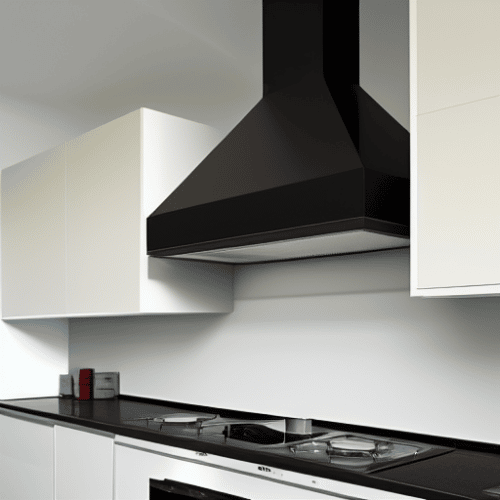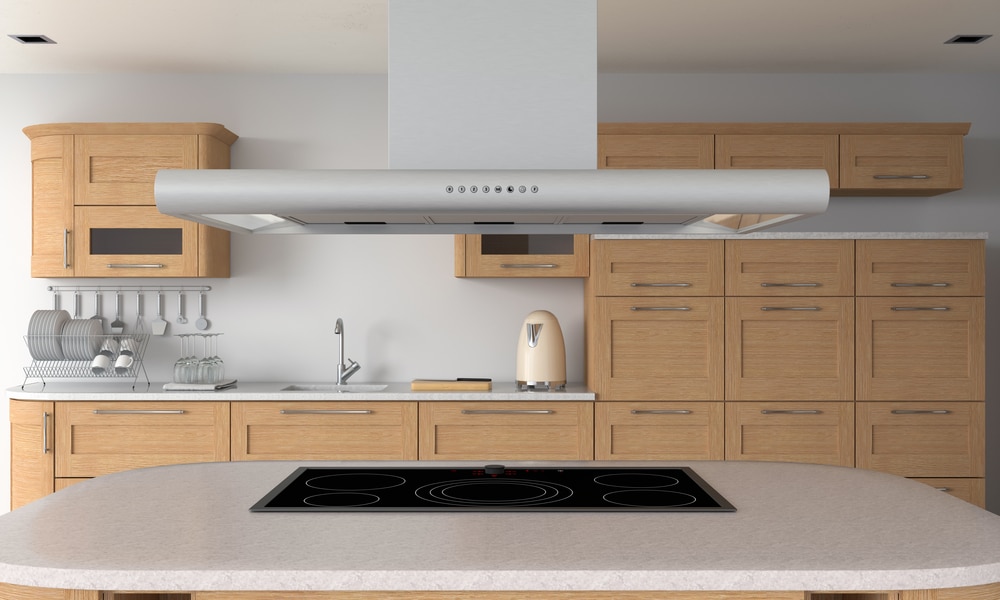Last Updated on
Cooker hoods are pretty much essential to ensuring your home doesn’t suffer from excess humidity. Additionally, it helps eliminate unpleasant odours and keeps your cooking surface from being covered in a thick oil film.
While cooker hoods are commonplace in most kitchens, you’ll want to check that you’re installing your model at the right height.
This guide will help you work out the right height for your cooker hood based on various factors. These include your hob type, width, and extraction rate. First, let’s get started by looking at the minimum distances you’ll need to install your hood in compliance with UK regulations.
Recommended Minimum Distances
While numerous factors will determine how high your cooker hood will need to be installed, there is no set cooker hood maximum height. There are, however, a set of minimum distances according to UK regulations.
- Minimum distance for a gas hob – 750mm between hood and gas hobs.
- Minimum distance for an electric hob/induction hob – 650mm between hood and induction hobs.
- Minimum distance for a mixed electric and gas hob – 750mm between the hood and mixed hobs.
Although these are the official minimum distances for safe usage, you should be aware that placing your hood considerably higher can result in a loss of performance for some models. Your unit will come with recommendations and detailed installation instructions provided by the manufacturer.
Read on to learn what other aspects you should take into consideration when deciding where to put your cooker stove in order to discover the ideal extractor fan height for your unit.
Cooker Hood Type
Aside from the above distances required for safe operation between your cooker hob and extraction hood, you’ll also need to consider the type of hood that you are installing and the included installation instructions.
Built-in Cooker Hoods
Compact and almost invisible, built-in extractor models are a popular choice for small kitchens. Ensure that your upper wall units will allow you to install your hood at the minimum recommended height for maximum effectiveness.
Visor Cooker Hoods
Visor hoods are somewhat dated nowadays but still provide a good space-saving option as they don’t take up precious cupboard space in small kitchens. Ensure that your wall-mounted cabinets allow you to install a visor hood beneath them while still respecting the minimum security distances.
Chimney Cooker Hoods
Large and often a great focal feature, chimney hoods are on the rise in popularity. They consist of a long metal chimney with a wide extractor, often available in various styles. Look for models with high extraction rates if you are thinking of installing your chimney hood much higher than the minimum height to ensure good performance levels.
Telescoping Canopy Cooker Hoods
Telescoping canopy hoods allow for a more flexible installation. They feature a motorised pull-out canopy that will enable you to position them in higher-up cabinets to lower your appliance when in use. You can easily find this type of appliance in style to best suit your overhead cabinet.
Ceiling Cooker Hoods
When installed high up for an unobstructed kitchen outline, ceiling hoods are a great way to extract air from the whole of your kitchen, not just over the hob area. So powerful, they are available in various styles and sizes, making ceiling extraction units an increasingly popular choice.
Kitchen Island Hoods
If you are installing an extractor hood over your kitchen island for an odour-free kitchen, you’ll want to install a special style that is designed to be viewed from all angles. To open up your kitchen and give you the feeling of more space, you may want to try installing your island extraction hood a little higher in smaller kitchens. If this is the case, make sure that you have sufficient width and power, as we’ll discuss in the following paragraphs.
Controls
If your extraction hood has traditional buttons, then you’ll want to install it at a height that allows for easy access. The power button switch and speed settings control will need to be within comfortable reach. On the other hand, if your hood comes with a remote control or can be voice-activated, then providing it has powerful enough extraction, you can install it higher up.
Extraction Rate
Your hood’s extraction rate will have been one of the deciding factors when you made your purchase. To work out the minimum recommended extraction rate for your kitchen, work out your kitchen’s approximate volume. You will want your extractor hood to be able to completely renew the air in your room at least ten times per hour for the best performance.
For example, if your room measures approximately 40m3, you will want to look for a hood with a 400m3 per hour airflow for the right extraction rate. This will be able to filter your room’s air at the recommended ten times per hour. So, even if you are cooking some particularly pungent foods, you won’t be stuck with any lingering smells.
As we mentioned earlier, locating your extractor hood considerably higher than the minimum distances can result in a loss of performance, so you may want to opt for a more powerful model if you are looking at installing your cooker hood higher up. Your hood’s extraction rate can, therefore, have a direct influence on your extractor hood height.
Recirculating Cooker Hoods
If you are looking for more flexibility when installing your over-hob extraction, you may be tempted to choose a recirculating hood over a traditional vented model. Unlike vented models, recirculating hoods do not need to vent air to the outside via a duct.
The problem with recirculating hoods, apart from their higher price tag, is that it is much less efficient to recirculate air around your room than venting it outside. Vented hoods get rid of heat, steam, and odours much effectively via an air duct. However, if you are considering purchasing a non-vented cooker hood, make sure that you opt for a model that has a powerful enough extraction rate for your room and considers installing it closer to the stated minimum distance of 750mm or 650mm, depending on your hob type.
Cooker Hood Width

If you consider installing your extractor much higher than the regulatory minimum distances above your worktop for aesthetic or practical reasons, you should consider purchasing a wider model. While it is recommended that you opt for a unit that matches the width of your hob, for higher-up hoods, you’ll want to install a model that is wider than your hob.
For example, if your hob is 60cm wide, consider installing an extractor with a width of 90cm if you are installing it over 750mm. For units that are 100cm wide, consider an extraction hood measuring 120cm for a higher installation. The greater width will allow for a more efficient extraction and grease absorption. This prevents grease and steam from escaping each side of your hood, which can happen with models of the same width as the hob located higher up.
Downdrafters – An Alternative Solution
Another solution to your kitchen cooker extractor dilemma could be to install a downdraft extractor or even a new hob complete with an integrated downdraft. Downdrafts are extremely powerful kitchen ventilation systems that suck hot air, smoke and steam down and out of your kitchen.
To fit a downdraft extractor, you will need space around your hob and enough cupboard space below to install the unit. When you use your hob, you press a button, and the appliance rises from below your kitchen work surface to eliminate grease, moisture and smells from your cooking area.
Do You Need a Cooker Hood?
If you are struggling to sort out fitting a cooker extractor in your kitchen, you may be wondering if you need one at all. While they are not compulsory, you will need some extraction appliance or ventilation inside your room to remove moisture and smells.
Otherwise, you will suffer from a build-up of humidity and odours. You will probably also end up having to replace certain parts of your fitted units, such as the underside of cabinets, that can be adversely affected by steam or grease from your hob when cooking without an extraction fan.
While a good, high-powered cooker hood can set you back a few hundred pounds or more if you are looking for a statement piece or a downdraft, it is most definitely a suitable investment that will make your home more comfortable. A cooker hood could also potentially save you a lot of money on replacing cabinets and redecorating your kitchen after damage caused by excess humidity and grease from cooking.
Keep Your Kitchen in Style
Cooker hoods are essential to keeping your kitchen comfortable and clean. While they are very simple and highly effective to use, installation can be a little complex. When planning your new kitchen layout or replacing your hob or a cooker hood, it’s important to make sure your installation looks good. You comply with UK cooker hood installation regulations, and your installation is effective. Follow our guide above to make sure that your cooker hood height is right for your kitchen. Also, make sure you read thoroughly through the manufacturer’s guidance and installation instructions before going ahead with your project.
Kelly is an expert in consumer product research, which is very important when it comes to finding the most useful and aesthetically pleasing items for your home. This became her passion after finding it very time-consuming to wade through all the product information online.
She has keen attention to detail which she brings to her articles. Kelly’s goal is to help you find what you need without spending too much time searching for it.



